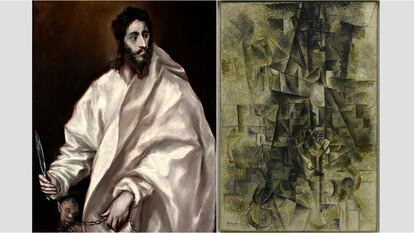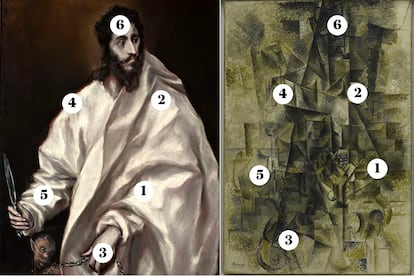Find six similarities between these two paintings by Picasso and el Greco
The Prado Museum in Madrid, Spain, is celebrating Picasso’s birthday with an exhibit about the Greek painter’s influence in the origin of Cubism

One of the claims that museums tend to use to justify hanging two pieces by different artists, from different eras and movements, side-by-side is dialogue. They say that the two paintings are in “dialogue” or that the two artists “converse.” Often, the spectators have to resort to guides and catalogs, or even continue researching after their visit, to understand that alleged conversation that they did not hear in the museum gallery.
One of the latest examples can be seen until September 17 in the Prado Museum, in Madrid, Spain: Picasso, el Greco y el cubismo analítico [Picasso, El Greco and Analytical Cubism]. One of the museum’s galleries displays four pairs of paintings by the two artists to explain how Picasso used El Greco to subvert the academic tradition he studied at the San Fernando Royal Academy of Fine Arts and move towards Cubism.
Curator Carmen Giménez has used Greco’s late apostle paintings to create a true dialogue between Picasso and one of the great masters of Western painting. They are bodies wrapped in tunics on a dark background, with intense frontal lighting. With Giménez’s help, we found the similarities between two of the paintings, one of the pairs.

The abstraction is in the cape
El Greco was educated in the post-Byzantine art tradition as an icon painter, a language in which the third dimension does not exist and figures inhabit an undefined space. This Saint Bartholomew responds to that style, above all, in Giménez’s words, “in the free construction of the cape” which allows Picasso similar freedom in Accordionist. “The geometric folds are practically cubist,” she adds.
“Cruel smudges”
That abstract tunic does not only seem to hang in a void, but it is also traced in an almost impressionistic way. “They are unfinished brushstrokes, sketched. He didn’t have a polished style of precise lines,” Giménez says, pointing out how Picasso borrows the technique, which he calls “cruel smudges” after Francisco Pacheco, the teacher and brother-in-law of Velázquez.
It looks like a hand
Carmen Giménez draws attention to how Greco paints the hand in this painting. “If you put it beside one by Velázquez, it does not look like a hand.” At the same time, it is very expressive. She refers to the same feature in the bodies of Resurrection, Pentecost and Crucifixion, all by the Creten, shown across from this pair of paintings.
Verticality over depth
None of the paintings in the exhibition are horizontal. El Greco chose the vertical format and an inverted perspective. Picasso takes it to Cubism with long, narrow formats. “If the figures from my blue phase are stretched, it is probably because of their influence,” the Malaga-born artist once recognized.
The color palette
Picasso’s Cubism is gray, brown, cream and ochre. In this case, the curator says, he does not copy the tones of Greco’s apostle, but the paintings seem to suggest otherwise.
A psychological, not physical, portrait
Saint Bartholomew’s face, says Giménez, does not look like that of a person. The curator finds in the masculine figure an abstraction far from reality. José Álvarez Lopera, art historian, defines the gesture and Greco’s intention in these words: “He conceives his apostles overflowing with energy, and at the same time withdrawn, detached from any contingencies.” It is the spectator’s job to find the references to a face in Picasso’s Accordionist and decide whether, in that Cubist deconstruction and intention, there is also a hit of indifference.
Sign up for our weekly newsletter to get more English-language news coverage from EL PAÍS USA Edition
Tu suscripción se está usando en otro dispositivo
¿Quieres añadir otro usuario a tu suscripción?
Si continúas leyendo en este dispositivo, no se podrá leer en el otro.
FlechaTu suscripción se está usando en otro dispositivo y solo puedes acceder a EL PAÍS desde un dispositivo a la vez.
Si quieres compartir tu cuenta, cambia tu suscripción a la modalidad Premium, así podrás añadir otro usuario. Cada uno accederá con su propia cuenta de email, lo que os permitirá personalizar vuestra experiencia en EL PAÍS.
¿Tienes una suscripción de empresa? Accede aquí para contratar más cuentas.
En el caso de no saber quién está usando tu cuenta, te recomendamos cambiar tu contraseña aquí.
Si decides continuar compartiendo tu cuenta, este mensaje se mostrará en tu dispositivo y en el de la otra persona que está usando tu cuenta de forma indefinida, afectando a tu experiencia de lectura. Puedes consultar aquí los términos y condiciones de la suscripción digital.
More information
Archived In
Últimas noticias
Most viewed
- Reinhard Genzel, Nobel laureate in physics: ‘One-minute videos will never give you the truth’
- Oona Chaplin: ‘I told James Cameron that I was living in a treehouse and starting a permaculture project with a friend’
- Pablo Escobar’s hippos: A serious environmental problem, 40 years on
- Charles Dubouloz, mountaineering star, retires at 36 with a farewell tour inspired by Walter Bonatti
- Why we lost the habit of sleeping in two segments and how that changed our sense of time











































